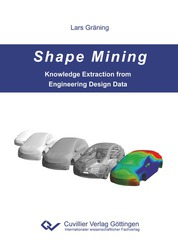| Areas | |
|---|---|
| Serie de libros (96) |
1378
|
| Nachhaltigkeit |
3
|
| Gesundheitswesen |
1
|
| Letra |
2364
|
| Ciencias Naturales |
5406
|
| Matemática | 229 |
| Informática | 319 |
| Física | 980 |
| Química | 1363 |
| Geociencias | 131 |
| Medicina humana | 243 |
| Estomatología | 10 |
| Veterinaria | 108 |
| Farmacia | 147 |
| Biología | 835 |
| Bioquímica, biología molecular, tecnología genética | 121 |
| Biofísica | 25 |
| Nutrición | 45 |
| Agricultura | 1004 |
| Silvicultura | 201 |
| Horticultura | 20 |
| Ecología y conservación de la tierra | 148 |
| Ciencias Ingeniería |
1793
|
| General |
98
|
|
Leitlinien Unfallchirurgie
5. Auflage bestellen |
|
Erweiterte Suche
Shape Mining (Tienda española)
Knowledge Extraction from Engineering Design Data
Lars Gräning (Autor)Previo
Indice, PDF (51 KB)
Lectura de prueba, PDF (140 KB)
The modeling of natural processes and physical configurations on computer systems has grown to a major cornerstone for an efficient product synthesis process. In recent years methods from computational intelligence and data mining have been adopted from engineers and computer aided engineering (CAE) tools to raise the exploitation of computational data and resources. The modeling of the design data and the extraction of knowledge through data mining technologies provides support for design engineers in the decision making process. So far, the multidisciplinary of a product design and the huge variability in computational design representations hinders the modeling and analysis of design data beyond individual design configurations and processes. This thesis introduces the concept of shape mining as a holistic approach to the analysis of engineering design data. Adopting unstructured surface meshes as a unified design representation facilitates the comparison and analysis of design shapes throughout the entire design synthesis process. Particular technologies from data mining, computational intelligence and information theory are summarized which are applicable to extract valuable knowledge from aerodynamic and structural design data. Suggestions for the utilization of the acquired knowledge are given to support the decision making process in engineering design. Practical shape mining examples are provided depicting its applicability in the synthesis processes of passenger car bodywork designs.
| ISBN-13 (Impresion) | 9783954048175 |
| ISBN-13 (E-Book) | 9783736948174 |
| Formato | A5 |
| Idioma | Inglés |
| Numero de paginas | 168 |
| Laminacion de la cubierta | mate |
| Edicion | 1. Aufl. |
| Lugar de publicacion | Göttingen |
| Lugar de la disertacion | Bielefeld |
| Fecha de publicacion | 07.10.2014 |
| Clasificacion simple | Tesis doctoral |
| Area |
Informática
Ingeniería |
| Palabras claves | Data Mining, Computer Aided Engineering, Unified Design, Representation, Design Concept, Sensitivity Analysis, Passenger Car Design, Interaction Analysis |








